How to change a kitchen faucet: remove the old faucet and install a new one
A breakdown of a kitchen faucet can happen at the most inopportune moment, when there is simply no time to wait for a plumber to arrive.Agree, the ability to replace a plumbing fixture is useful to every home handyman. Moreover, you don’t need special skills or expensive tools to do the job.
Before you change the faucet in the kitchen, you need to understand its structure and have a clear idea of the procedure. We will help you in these matters.
The article provides detailed instructions for dismantling old devices and installing new models, taking into account their design features. Having studied the material, you can easily cope with the work and save your family budget on calling a plumber.
The content of the article:
Types of mixing devices for the kitchen
The reasons for changing an appliance can be different, ranging from a decrease in its functionality due to wear of individual parts, and ending with replacement in order to adjust the mixer to the overall interior of the kitchen.
Regardless of the reason for the replacement, the process of dismantling and subsequent installation is almost monotonous. And the owner of the kitchen, first of all, needs choose the right mixer.
The following parameters should be assessed:
- designer uniform;
- configuration;
- manufacturing material.
The design form is a choice at the personal discretion of the kitchen owner, but at the same time, when planning to change the appliance, it is advisable not to deviate from the overall picture of the kitchen interior. The mixer configuration must match the installation method.
Let us remind you that there are two common methods for installing kitchen faucets:
- wall;
- desktop
As a rule, in the kitchen, tabletop faucets are used, designed to be located on the panel of the utility sink or on the side of the sink. Wall-mounted ones are gradually going out of fashion or are used as part of luxury kitchen interiors.
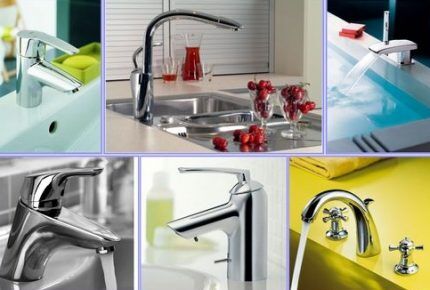
Also, the owner of the kitchen who decides to change the plumbing is given the opportunity to choose from two types of devices according to the method of controlling the water flow. One type - designs with two taps (herringbone) and another type - single lever type designs, where mixing of water is carried out with one lever.
The materials for the manufacture of mixing plumbing fixtures are usually silumin, brass, bronze, and ceramics. Devices based on silumin are less durable than brass and others.
Distinguish silumin mixers can be adjusted by weight and market price (they are lighter and cheaper). It is more practical to choose brass, bronze, ceramic products. Their price is more expensive, but they will last much longer, so in the long run such products look more economical.
Instructions for replacing the mixer
A detailed description of the steps to reinstall mixing equipment will help you avoid mistakes if you decide to replace it for the first time.
Tool and installation kit
Dismantling and installation of a traditional kitchen sink accessory is carried out using the following plumbing tools:
- adjustable wrench - gas wrench number one;
- wrenches (10*12, 13*14);
- socket wrench with deep stock (10*12, 13*14);
- wire brush,
- fluoroplastic ribbon - PTFE.
When solving the problem of how to replace or repair a faucet in the kitchen, the installer must have a complete installation set. This is a set of all the necessary elements: gaskets, connecting hoses, nuts, screws, washers, etc., which are usually sold along with the device.
The manufacturer supplements any kitchen faucet kit with instructions that outline the installation sequence of such a device.
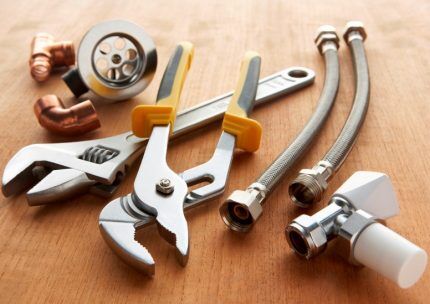
In addition to the installation tool, you will need household accessories: rags, bucket or basin. Thanks to these items, it is possible to minimize the spreading of water remaining in the pipelines when the dismantling process is carried out.
It is advisable to have a miniature flashlight, since usually replacing a tabletop kitchen faucet involves working in dark conditions - under the sink, under the sink.
Read the article: Rating of the best wrenches.
Removing a kitchen faucet
The first step is to stop the supply of water (cold, hot) to the mixer - close the linear taps on the centralized supply pipes. After shutting off the lines, you need to open the mixer valves and make sure that no water flows. If there is a water leak, this indicates wear and tear. line shut-off valves.
In this case, you will first have to replace the taps on the water supply lines and only then continue working in the kitchen.

If there is no water leakage, dismantling work can continue. Under the sink there are flexible connecting hoses (40-60 cm long) that must be removed.
A flexible line is attached to the centralized line slip-on nuts. It is convenient to unscrew them using an adjustable (gas) wrench. Flexible hoses are attached to the mixer body with tubular fittings. Here, to unscrew the fittings, you need a 13*14 or 10*12 wrench, depending on the modification.
After the flexible hoses are disconnected, it is time to dismantle the mixer itself. It is held on the sink thanks to two hex nuts and a special pressure washer.
The nuts are screwed onto two long studs about 50-60 mm long. Therefore, when replacing, it is most convenient to use a tubular socket wrench. The mounting assembly is located in the lower area of the faucet, so working under the sink is common practice in most cases.
When the screws are unscrewed, the support washer is removed from the studs, after which the mixer is easily removed.
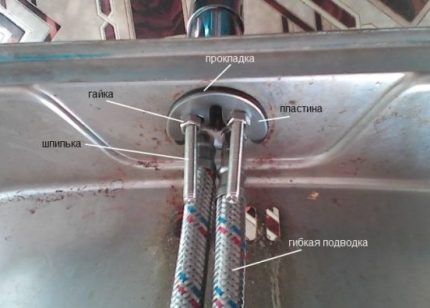
Wall-mounted models are rarely installed in kitchens, but this replacement option is also not excluded. Unlike the desktop method, there is no flexible liner. The device is rigidly mounted directly on branch pipes from the centralized main.
The pipes, in turn, are walled up in the wall, and only the threaded ends are left for connection. To dismantle and replace a wall-mounted kitchen faucet, you need to unscrew two nuts and then remove the device.
Checking a new device
A new appliance, purchased to replace an old kitchen faucet, is removed from the packaging. It is necessary to carefully inspect the structure for defects and damage.
Branded plumbing stores, as a rule, accept and exchange defective goods, repair them or return money. The main thing is to have a sales receipt in hand.
On the mixer, you need to carefully check the mechanical parts and functionality:
- rotation of flow regulators;
- integrity of threads at joints;
- quality of flexible connecting hoses.
Depending on the model of the device, the rotation of the taps or the movement of the lever should be accompanied by a slight, smooth motion. The presence of even small defects in the places of the connecting thread is excluded, otherwise at the time of installation, when screwing on the nuts, the risk of damage to the entire connecting unit increases.
The nickel-plated coating of the mixer must be smooth, uniform (without swelling), no scratches or dents.The protective metal casing of flexible hoses must not be damaged.
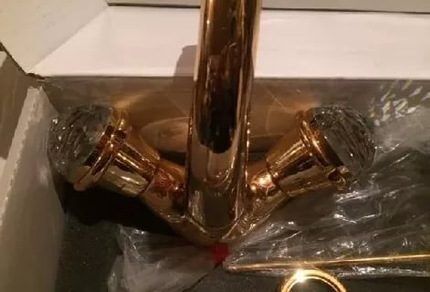
Crane installation technology
Before installing the mixer, you should clean the outlet internal openings of the water pipes from scale and rust, and also clean the threads on the pipes from any remaining sealing material.
It is convenient to do this work with a rough metal brush. The place where the faucet sits on the sink should also be cleaned of scale and oxides, but without a brush - using a rag. If the sink is easily removed from the base, it is recommended to remove these kitchen accessories for ease of installation of the appliance.
You need to screw the two flexible armored hoses included in the kit onto the mixer - one for hot water, the other for cold water. Before screwing the hoses into the tubular fittings, you need to put on rubber gaskets, which are also included in the delivery kit.
The hoses are screwed in by hand until they stop, then with a little effort they are tightened two or three turns with a wrench.
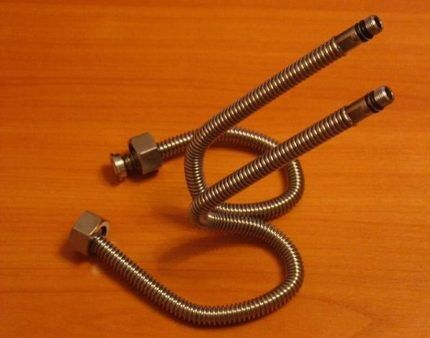
At the next stage, the device equipped with a flexible hose should be installed at its location on the sink. Insert flexible hoses into the mounting hole of the sink (sink) with a diameter of 34 mm and lower the device onto the surface.
From the bottom of the sink cloth, you need to get to the bottom of the mixer, put a sealing washer on the studs and tighten it with nuts to the sink cloth, but not all the way.
It is necessary to leave a slight free movement of the mixer body so that it is possible to align the device in the center of the mounting hole. After centering the mixer, tighten the nuts on the studs until they stop.
Having completed mounting the device on the side of the sink, you need to connect the ends of the flexible hoses to the main pipelines. The designs of modern flexible hoses are equipped with fitting nuts with already installed rubber gaskets.
The installer can only carefully, precisely along the threads, screw the fitting nuts onto the ends of the pipes until they stop and tighten them with a gas wrench two or three turns.

Flexible hoses for kitchen plumbing are available in different lengths. When installing, you should be guided by the rule that it is imperative to leave some slack in the hoses. For example, for a distance between connection points of 520 mm, use a liner with a length of at least 600 mm.
At this stage of work it is necessary to perform installation water filterif you plan to use it.
The pin mount is typically used on single-lever and touch-sensitive instruments. Devices with two separate control valves have a slightly modified mounting assembly.
Here, a support washer with one tightening nut is used, which is screwed onto the lower part of the mixer body. With this option, small wrenches are no longer required. Instead, when replacing the mixer, an adjustable or gas wrench is used.
A feature of installing a wall-mounted device is the need to use a device of a different configuration, namely, with two separated inputs.
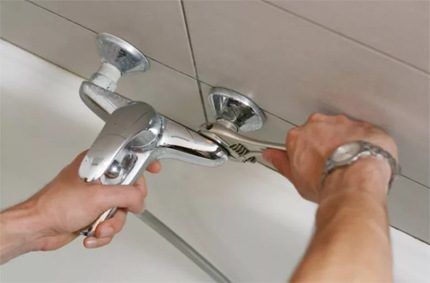
The inlets of the wall-mounted kitchen faucet must correspond to the center-to-center distance of the ends of the pipelines. If there is no match, use the eccentric adapters included in the delivery kit.
Features of installation of different models
Tactics may differ - the order of work depends on the design features of the mixer. Let's look at the possible installation options step by step.
Photo instructions for installing a mixer with a clamping nut
For installation on the currently popular metal sinks, faucets with a clamping nut screwed from below are ideal. Before starting work on the sink, it is necessary to select an area without relief in order to place the base of the device on a completely flat surface.
The installation technology of this type of mixer has its own specifics:
A quick guide to installing a faucet on studs
The specificity of plumbing operations with this type of mixer is that the flexible line must be secured before installing the device in place.
This sequence is due to the impossibility of tightening them after placing them in the mounting hole:
Installation of exotic semi-professional models
The designs of plumbing fixtures are constantly being improved. This also applies to faucets that are used in the kitchen.
Increasingly, there are buyers who want to replace a regular faucet in the kitchen with a touch-sensitive device or thermostatic mixer. From a mechanical point of view, the installation of electronic structures is almost similar to the installation of traditional models.
However, there are some nuances associated with electronic control of devices:
- installation of batteries or external power supply;
- setting temperature conditions and storing them in the “memory” of the device;
- adjusting the sensitivity of sensors.
Semi-professional appliances with a high spout, 360° swivel and a pull-out shower are usually installed in a kitchen where two sinks or one with two separate sinks are used.
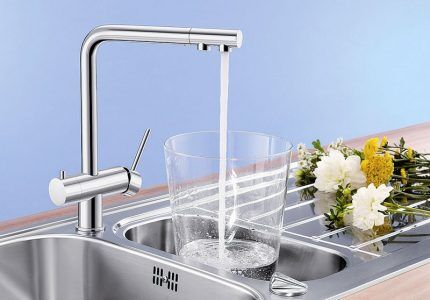
Replacing such devices also does not differ much from the standard method, with the exception of some details. For example, the arrangement of fasteners may be changed, and bolts may be used instead of studs.
Modules with faucet axle boxes in designer models can be installed separately from the spout, as, for example, in the version of the mixer presented below with a combined outlet:
Pressure testing and commissioning
It is recommended to pressurize the assembled structure and check for leaks. To do this, the taps on the mixer must be closed (on a lever model, lower the lever all the way). Open the linear taps on the hot/cold water lines one by one, and then carefully inspect all installation connections, as well as the mixer itself.
If after 15-20 minutes no water leak is detected, the installation was completed efficiently. You can safely start using your new faucet in the kitchen.
Before starting operation, it is necessary to remove the aerator from the mixer body - mesh filter. In this position, open the taps and run water for a short time in order to wash out the particles of rust, oxides, and scale remaining in the pipelines.
After the procedure, put the aerator back in place and test the water flow in filtration mode. The stream should come out smooth, without splashing water to the sides.

Typically, well-known manufacturers provide a warranty of at least 5 years on devices. During this period, claims from buyers are accepted. The warranty period is provided kitchen faucet repair at the expense of the manufacturer if manufacturing defects, the introduction of low-quality materials, etc. are discovered.
In this case, repairs are carried out within 20 working days, unless there are justified reasons for extending this period. However, in the history of returns, there is one important point - the warranty remains valid if the mixer was dismantled only after inspection by a representative of the manufacturer.
Conclusions and useful video on the topic
Visual instructions for replacing an old mixer or installing a new device:
Any DIYer can replace the faucet on his own. If such work is being carried out for the first time, then the main thing is not to rush and perform all actions according to the installation instructions. A scrupulous approach will ensure the tightness of the joining of elements and the duration of uninterrupted operation of the plumbing fixture.
If you have experience dismantling and installing a kitchen faucet, please share your practical skills with our readers. Leave comments and ask questions on the topic in the form below.




Dear authors, let me correct you! What is called "silumin" in faucets is not actually silumin, but a zinc alloy with a zinc content of approximately 95%.In everyday life, plumbers also use the abbreviation TsAM to designate this material. It is this zinc alloy that is used in cheap faucets, as well as in expensive ones if their manufacturer is dishonest. It is this zinc alloy that gradually breaks down under the influence of water (especially hot water). Mixer bodies made of this alloy crack or even break through. The technical properties of the TsAM alloy are such that products made from it cannot come into contact with water at all! That's what's scary!
And, by the way, faucets made from TsAM have not been lightweight for a long time. They learned how to weigh them down and paint them the color of brass.
It is not known where this misconception about “silumin” came from, but it has become so popular that manufacturers of goods made from real silumin are now trying in every possible way to disguise the material of their own products with other names, because the attitude “silumin is a crappy material” has long been firmly established in the subconscious of the average person. But silumin is an alloy of aluminum and silicon (silicon content can vary from 4% to 22%). Sectional radiators are made from silumin. And they call them aluminum, although in fact they are made of silumin. And they call them that because the Russian consumer is already, one might say, intimidated by the word “silumin”.
I change faucets almost every two years. So, there is no question of a five-year warranty. The store provides a one-year warranty. Experience shows that lever-type faucets with a clamping nut are more convenient to install and use. Using the lever, you can simultaneously regulate the pressure and temperature of the water, even with the back of your hand. A large nut is more accessible for tools and securely fixes the valve body.
I’ll take the risk of changing it myself, or rather installing a new mixer. I have a nut... I think there is nothing complicated.